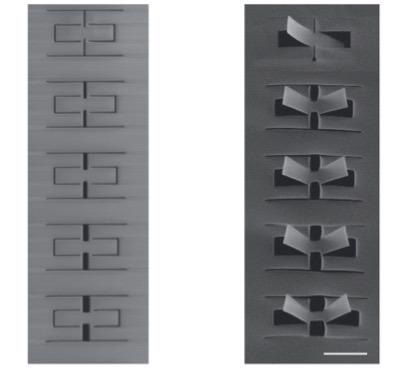Dec 23 2020
Elaborate paper cards, pop-up children’s books and paper snowflakes are interesting not only to crafters but also to other individuals.
 New research allows each kirigami motif to bend into multiple shapes. Image Credit: Northwestern University.
New research allows each kirigami motif to bend into multiple shapes. Image Credit: Northwestern University.
A group of engineers from Northwestern University has created an advanced alternative to 3D printing by applying concepts taken from paper-folding practices.
The word Kirigami comes from the Japanese words 'kiru' (to cut) and 'kami' (paper). It is a classical form of art, wherein the paper is accurately cut and changed into a 3D object.
With the help of thin films of material and software to choose the precise geometric cuts, engineers can now produce an array of intricate structures by taking a clue from the paper-folding practice.
Published in 2015, the study demonstrated potential in the kirigami 'pop-up' fabrication model. In this kind of iteration, the ribbon-like structures produced by the cuts were actually open shapes, with reduced potential to achieve closed shapes. Other studies based on the same inspiration have chiefly demonstrated that kirigami can be used at a macroscale using simple materials, such as paper.
However, a new study recently published in the Advanced Materials journal on December 22nd, 2020, takes the process one step ahead.
According to Horacio Espinosa, a mechanical engineering professor from the McCormick School of Engineering, his group was able to use the ideas of design and kirigami on nanostructures. Espinosa, who headed the new study, is also the James N. and Nancy J. Farley Professor in Manufacturing and Entrepreneurship.
By combining nanomanufacturing, in situ microscopy experimentation, and computational modeling, we unraveled the rich behavior of kirigami structures and identified conditions for their use in practical applications.
Horacio Espinosa, Mechanical Engineering Professor, McCormick School of Engineering, Northwestern University
The investigators began by producing 2D structures using advanced semiconductor manufacturing techniques and meticulously placed 'kirigami cuts' on ultrathin films. Residual stresses in the ultrathin films cause structural instabilities that subsequently yield well-defined 3D structures.
These engineered kirigami structures could be used in several applications, such as spatial light modulators, microscale grippers (for example, cell picking), and flow control in airplane wings. Such capabilities make the novel method suitable for promising applications in aerospace, energy harvesting and biomedical devices.
Generally, a single kirigami motif can be used to create only a certain number of shapes. However, by using the differences in the cuts, the researchers effectively demonstrated film bending and twisting that lead to a broader range of shapes—such as both asymmetrical and symmetrical configurations.
For the first time, the team showed that microscale-structures, using film widths of just a few tens of nanometers, can attain unique 3D shapes and offer a wider functionality.
For instance, electrostatic microtweezers tend to close quickly, which can be aggressive on soft samples. On the other hand, kirigami-based tweezers can be designed to accurately regulate the grabbing force by adjusting the amount of stretching.
In this application and other similar ones, the potential to design cut locations and estimate the structural behaviors based on computer simulations removes trial and error, saving time and money in the process.
As their study progresses, the team has planned to analyze the massive space of kirigami designs, such as array configurations, to obtain a greater number of potential functionalities, added Espinosa.
Integrating the distributed actuators for deployment and control of kirigami is another area for upcoming studies. By exploring the method further, the researchers believe that kirigami can have potential applications in aerospace, architecture and environmental engineering.
The study was funded by the U.S. Department of Energy (contract number DE-AC02-06CH11357). Espinosa and David Lopez from Penn State are the co-first authors of the study.
Kirigami engineering in action
Video Credit: Northwestern University.
Journal Reference:
Zhang, X., et al. (2020) Kirigami engineering—Nanoscale structures exhibiting a range of controllable configurations. Advanced Materials. doi.org/10.1002/adma.202005275.